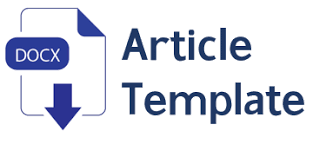The Effect of Preeclampsia Prevention Videos on Knowledge, Attitudes and Self-Efficacy of Pregnant Women in Semarang City, Indonesia
Downloads
Background: Preeclampsia is one of the leading causes of maternal mortality in the world, so efforts are needed to prevent preeclampsia. Prevention efforts can be carried out through health education with videos, given the development of information technology that makes it easier to deliver health information. Objective: This study aims to determine the effect of education and the magnitude of changes in values using videos about preeclampsia on knowledge, attitudes and self-efficacy of pregnant women. Methods: This study is a quantitative study with a quasi-experimental design with a pretest posttest with control group design. The research sample was 30 pregnant women in the intervention group and 30 people in the control group. Conclusion: Statistical tests using Wilcoxon in the intervention group showed an increase in the value of knowledge, attitudes and self-efficacy after getting the intervention with a p-value of 0,000 or < 0,05. Statistical tests using Mann Whitney found that there was no initial difference in knowledge, attitudes and self-efficacy of pregnant women in the intervention group and control group, but after getting the intervention in both groups it was known that there were differences in knowledge, attitudes and self-efficacy after getting the intervention with a p-value of 0,000 or < 0,05. And statistical tests using the Linear Mixed Model found that there was an increase in knowledge scores by 15,93%, attitudes by 5,82% and self-efficacy of pregnant women by 6,35% due to the intervention. Conclusion: There is an effect of providing education using video media and leaflets on knowledge, attitudes and self-efficacy in pregnant women compared to only using leaflets, there are differences in the scores of knowledge, attitudes and self-efficacy of pregnant women in the intervention group and control group after receiving education using video, and there is an increase in knowledge scores, attitudes and self-efficacy after receiving the intervention.
Amalia, Z., Pamungkasari, A. P. and Priyatama, A. N. (2024) ‘Pengaruh Edukasi Gizi Melalui Video dan Booklet terhadap Peningkatan Pengetahuan, Sikap dan Perilaku Ibu Hamil dalam Pencegahan Stunting’, Media Penelitian dan Pengembangan Kesehatan, 34(4), pp. 962–973. doi: https://doi.org/10.34011/jmp2k.v34i4.2303 973.
Fasimi, R. H., Rahayuning, R. T. and Pratiwi, R. D. (2023) ‘Pengaruh Edukasi Media Booklet dan SMS Pengingat terhadap Pengetahuan Ibu Tentang Preeklampsia di Jalur Pipa Gas Kota Pamulang Timur’, Prosiding SENANTIAS: Seminar Nasional Hasil Penelitian dan PKM, 4(1), pp. 714–719.
Herinawati, H. et al. (2021) ‘Efektivitas Self Efficacy terhadap Pemahaman Tanda Bahaya Kehamilan menggunakan Video dan Buku Kesehatan Ibu dan Anak’, Jurnal Akademika Baiturrahim Jambi, 10(1), p. 109. doi: 10.36565/jab.v10i1.290.
Imiliana, I., Dewi, N. P. and Yuliyantina, E. V. (2024) ‘PENGARUH EDUKASI VIDEO TERHADAP PENGETAHUAN IBU HAMIL TRIMESTER III TENTANG’, Jurnal Kesehatan, 13(2), pp. 221–230. doi: 10.37048/kesehatan.v13i2.452.
Istiqomah, H., Marsiwi, A. R. and Haryanti, S. (2022) ‘Hubungan Pengetahuan dan Sikap dengan Perilaku Pencegahan Kegawatdaruratan Preeklamsia pada Ibu Hamil di Puskesmas Cibungbulang’, Jurnal Nasional Kebidanan Indonesia, 4(2), pp. 144–153. Available at: https://openjournal.wdh.ac.id/index.php/NA/article/view/961.
Kementrian Kesehatan RI (2024) Webinar Save Mother Save The Nation. Available at: https://lms.kemkes.go.id/courses/f5ce874c-e40f-43e2-96f4-eb396276787c.
Meldafia, I., Yulia Darma, I. and Deferma, M. (2023) ‘Efektivitas Penyuluhan Kesehatan Dengan Menggunakan Media Video Dalam Meningkatkan Pengetahuan Ibu Hamil Tentang Preeklampsia’, Jurnal Ilmu Keperawatan dan Kebidanan, 14(1), pp. 142–147. doi: 10.26751/jikk.v14i1.1617.
MReda, D. M. et al. (2024) ‘Effect of Video-assisted Teaching Programs on the Knowledge , Practices , and Attitude of Pregnant Women at Risk for Preeclampsia Effect of Video-assisted Teaching Programs on the Knowledge , Practices , and Attitude of Pregnant Women at Risk for Preeclam’, International Egyptian Journal of Nursing Sciences and Research (IEJNSR), 4(2), pp. 271–285. doi: 10.21608/ejnsr.2024.255570.1340.
Phipps, E. A., Thadhani, R. and Thomas Benzing, S. A. K. (2019) ‘Pre-eclampsia: pathogenesis, novel diagnostics and therapies’, Journal of the National Medical Association, 15(5), pp. 275–289. doi: 10.1038/s41581-019-0119-6.Pre-eclampsia.
Sriatmi, A. et al. (2020) ‘Dapatkah Kelas Ibu Hamil Model Virtual Meningkatkan Praktik Pencegahan Risiko Tinggi Kehamilan ?’, Media Penelitian dan Pengembangan Kesehatan. doi: 10.22435/mpk.v30i1.2985.
Sriatmi, A., Jati, Sutopo, P. and Budiyanti, Rani, T. (2020) ‘Dukungan dan Persepsi terhadap Perilaku Pencegahan Komplikasi Kehamilan’, Higeia Journal of Public Health Research and Development, 1(3), pp. 84–94.
Suparji, S. (2024) ‘Commentary High maternal mortality rate in Indonesia : a challenge to be addressed immediately’.
Ugurlu, M., Yavan, T. and Karasahin, K. E. (2021) ‘The Effect of an Education and Counseling Program on Maternal/Neonatal Outcomes in Pregnant Women at Risk of Preeclampsia.’, Puerto Rico health sciences journal, 40(3), pp. 127–135.
Ulfah, M. and Anggraeni, S. (2023) ‘The Effect of Attitudes, Subjective Norms, and Perceptions of Behavioral Control on Pregnancy Check-ups in Bojonegoro’, Jurnal Promkes, 11(1), pp. 93–100. doi: 10.20473/jpk.v11.i1.2023.93-100.
WHO (2025) Maternal Mortality, World Health Organization. Available at: https://www.who.int/news-room/fact-sheets/detail/maternal-mortality#:~:text=health system failures that translate,and reproductive health services; and (Accessed: 23 April 2025).

This work is licensed under a Creative Commons Attribution-NonCommercial-ShareAlike 4.0 International License.

In order to be accepted and published by Jurnal Promkes: The Indonesian Journal of Health Promotion and Health Education, Author(s) who submit an article should complete all the review process. The copyright of received articles assigned to the Jurnal Promkes: The Indonesian Journal of Health Promotion and Health Education,and Department of Health Promotion and Behavior Science, Universitas Airlangga as publishers of the journal. The intended copyright includes the rights to publish articles in various forms (including reprints).
Jurnal Promkes: The Indonesian Journal of Health Promotion and Health Education's website. Authors are allowed to use their works for any purposes deemed necessary without written permission from Jurnal Promkes: The Indonesian Journal of Health Promotion and Health EducationS and/or Department of Health Promotion and Behavior Science, Universitas Airlangga with an acknowledgement of initial publication in this journal.
The Editorial Team of Jurnal Promkes: The Indonesian Journal of Health Promotion and Health Education and Department of Health Promotion and Behavior Sciences strive to ensure that no errors occur in the articles that have been published, both data errors and statements in the article.
Users of this website will be licensed to use materials from this website following the Creative Commons Attribution-NonCommercial-ShareAlike 4.0 International License. No fees charged. Please use the materials accordingly.
------------------------------------------------------------------------------------------------------------------------------------------------------------------------------------------
Attribution ” You must give appropriate credit, provide a link to the license, and indicate if changes were made. You may do so in any reasonable manner, but not in any way that suggests the licensor endorses you or your use.
NonCommercial ” You may not use the material for commercial purposes.
ShareAlike ” If you remix, transform, or build upon the material, you must distribute your contributions under the same license as the original.


























